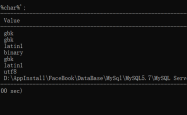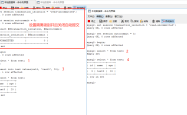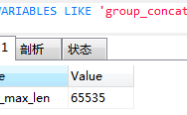JDBC连接的六步实例代码(与mysql连接)
吾爱主题
阅读:290
2024-04-02 08:02:07
评论:0
JDBC的六步:
1.注册驱动
2.获取数据库的连接
3.获取数据库的操作对象
4.执行sql语句
5.处理查询结果集(如果执行的语句中没有select语句这一步不用写)
6.关闭资源
第一步:注册驱动
?| 1 2 3 4 5 6 7 8 9 10 11 | //异常一定是需要处理的 //根据版本不同书写的代码有一些变化,老版本是 DriverManager.register( new com.mysql.jdbc.Driver()); //或者 Class.forName( "com.mysql.jdbc.Driver" ); //新版本是 DriverManager.register( new com.mysql.cj.jdbc.Driver()); //或者 Class.forName( "com.mysql.cj.jdbc.Driver" ); |
第二步:获取数据库的连接
?| 1 2 3 4 5 6 7 8 9 10 11 | //因为要进行try..catch,还要关闭这个资源,因此写在try外边且赋值为空 Connection conn = null ; ... //返回值是Connection,老版本和新版的url书写也不一样 // jdbc:mysql://localhost:3306/t_use这个前面的都一样,把t_use更改为自己的数据库名 //老版 conn = DriverManager.getConnection( "jdbc:mysql://localhost:3306/t_use" , "用户名" , "密码" ); //新版 conn = DriverManager.getConnection( "jdbc:mysql://localhost:3306/t_use?serverTimezone=GMT%2B8" , "用户名" , "密码" ); |
第三步:获取数据库操作对象
?| 1 2 3 4 5 | //这个和刚才的Connection是一样的 Statement st = null ; ... //这样就把对象创建好了 st = conn.createStatement(); |
第四步:执行sql语句
?| 1 2 3 4 5 6 7 8 9 10 | //引号里面写sql语句 String sql = " " ; //再用刚才创建好的对象接入这个sql语句 //这里还有需要说的,如果不是select语句就用下面这个,返回值是一个int,这个就不需要第五步了 st.executeUpdate(sql); //如果sql语句是select的话,就要用下面的这个语句了,还需要定义一个ResultSet对象,去接收这个值 //然后进行第五步的处理 ResultSet rs = null ; //和Connection一样的 rs = st.executeQuery(sql); |
第五步:处理查询结果集
?| 1 2 3 4 | //这个只有select语句才进行处理,不仅可以getString还可以getInt等 while (rs.next()){ String str = rs.getString( "需要输出的字段的名字" ); } |
第六步:关闭资源
?| 1 2 3 4 5 6 7 8 9 10 11 12 13 14 15 16 17 18 19 20 21 22 23 24 25 | //前面五步都是在try里面进行的,第六步是在finally进行的 //关闭连接 if (rs != null ) { try { rs.close(); } catch (SQLException throwables) { throwables.printStackTrace(); } } if (st != null ) { try { st.close(); } catch (SQLException throwables) { throwables.printStackTrace(); } } if (conn != null ) { try { conn.close(); } catch (SQLException throwables) { throwables.printStackTrace(); } } |
关闭连接也是有顺序的,先关ResultSet,再关Statement对象,最后关Connection对象.
完整代码
?| 1 2 3 4 5 6 7 8 9 10 11 12 13 14 15 16 17 18 19 20 21 22 23 24 25 26 27 28 29 30 31 32 33 34 35 36 37 38 39 40 41 42 43 44 45 46 47 48 49 50 51 52 53 54 55 56 57 58 59 | package jdbc.com; import com.mysql.cj.protocol.Resultset; import java.sql.*; public class Test02 { public static void main(String[] args) { Connection conn = null ; Statement st = null ; ResultSet rt = null ; try { //注册连接(可以写到一行里面) //com.mysql.cj.jdbc.Driver Driver = new com.mysql.cj.jdbc.Driver(); DriverManager.registerDriver( new com.mysql.cj.jdbc.Driver()); //获取数据库连接 conn=DriverManager.getConnection( "jdbc:mysql://localhost:3306/liu2?serverTimezone=GMT%2B8" , "用户名" , "密码" ); //获取数据库操作对象 st = conn.createStatement(); //执行sql语句 String sql = "select ename,sal from emp order by sal desc" ; rt = st.executeQuery(sql); //处理查询语句 while (rt.next()){ String ename = rt.getString( "ename" ); String sal = rt.getString( "sal" ); System.out.println(ename + "," + sal); } } catch (SQLException throwables) { throwables.printStackTrace(); } finally { //关闭连接 if (rt != null ) { try { rt.close(); } catch (SQLException throwables) { throwables.printStackTrace(); } } if (st != null ) { try { st.close(); } catch (SQLException throwables) { throwables.printStackTrace(); } } if (conn != null ) { try { conn.close(); } catch (SQLException throwables) { throwables.printStackTrace(); } } } } } |
最后,这个如果要传入值的话,可能会造成sql的注入,解决办法就是把Statement变成PreparedStatement,就可以避免sql的注入问题了,只不过第三步和第四步代码有点变化,就不再多说了。。
总结
到此这篇关于JDBC连接(与mysql连接)的文章就介绍到这了,更多相关JDBC与mysql连接内容请搜索服务器之家以前的文章或继续浏览下面的相关文章希望大家以后多多支持服务器之家!
原文链接:https://blog.csdn.net/zhinaijiangya/article/details/116566015
声明
1.本站遵循行业规范,任何转载的稿件都会明确标注作者和来源;2.本站的原创文章,请转载时务必注明文章作者和来源,不尊重原创的行为我们将追究责任;3.作者投稿可能会经我们编辑修改或补充。











